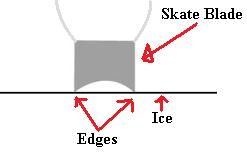My Klingbeil ice skates.
Happy Belated Groundhog Day! Although, spring will be early this year, there is still winter weather to contend with. One of my favorite winter activities is ice skating, so I decide to share some information about the special shoes known as ice skates. This will be a series of posts.
Some personal background, I am a figure skater and have been skating for over ten years.
History:
Ice skates have been around for the past 5000 years (Bellis, n.d.). They were invented in Finland as a means of traveling in the cold winter months (Lovgren, 2008). The oldest pair of ice skates was found in the bottom of a Swedish lake and date back to 3000 BCE. These skates were made from the legs of animals. Holes were cut into the bones so leather straps could be used to tie them to one’s feet, see image below (Bellis). The bones were shaved flat on the bottom and skaters used ski-pole like sticks with sharp points to grab the ice (SkateNY, 2007).
Early bone ice-skates. (From National Geographic)
In the 14th century, the Dutch started using metal blades. At first skates used poles but around 1500, blades with edges were invented. Edges allow blades to dig it to the ice, which allows skaters to push and glide with their feet (see image below). The edge technology is still used today (Bellis).
In 1865, American ice skater Jackson Haines invented the two plate metal blade. This blade is made of a narrow sharp part perpendicularly attached to flat metal plate. This flat area can be directly attached to boots. The new blades allow jumps and spins (Bellis).
A diagram of a blade. The top flat parts are the second plate, which is attached to the boot. The point part on the left is the toe pick. (From freepatentsonline)
In the 1870s, the toe pick was invented (Bellis). The toe-pick is the point part of the blade near the toe on figure skates (see image above). Although a toe-pick may look scary, it helps figure skates keep their feet straight and is used for toe-jump and footwork.
Now, ice skate technology has emerged to make them more supportive for more difficult tricks. They boots and blades are also being made strong lighter weight materials to aid in speed and jump height.
Do you enjoy ice skating? Do you find the history of ice skates fascinating?
Stay tuned for parts two and three on how to buy, lace, and maintain ice skates.
Also, a big thank you to all Facebook fans! You can now find the Through the Sole Facebook fan page at the direct url https://www.facebook.com/throughthesole.
For more frequent updates, follow me on twitter @jennyanne211, or become a fan on facebook
How to Buy Ice Skates
How to Tie Ice Skates
Shoes for Winter Weather
The Controversial Ugg Boot
Tweet
Other Post You May Enjoy:
Sources:
Bellis, M. (n.d.). History of ice skates. About.com. Retrieved February 2, 2011 from http://inventors.about.com/library/inventors/bliceskates.htm.
Lovgren, S. (Jan. 4, 2008). Bone ice skates invented by ancient Finns, study says. National Geographic. Retrieved February 3, 2011 from http://news.nationalgeographic.com/news/2008/01/080104-first-skates.html.
SkateNY. (May 25, 2007). A brief history of ice skates. Retrieved February 2, 2011 from http://www.skateny.com/skates/.









No comments:
Post a Comment